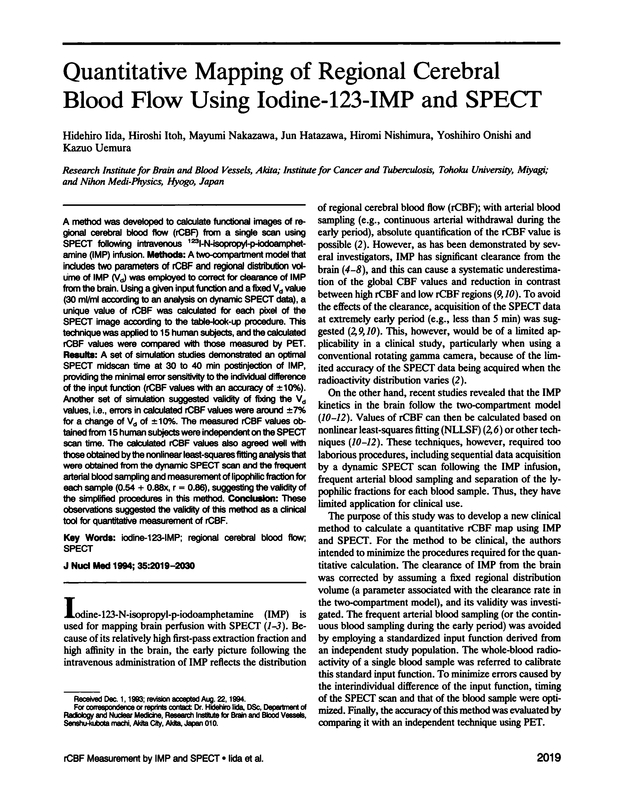Research ArticleMethodology
Quantitative Mapping of Regional Cerebral Blood Flow Using Iodine-123-IMP and SPECT
Hidehiro Iida, Hiroshi Itoh, Mayumi Nakazawa, Jun Hatazawa, Hiromi Nishimura, Yoshihiro Onishi and Kazuo Uemura
Journal of Nuclear Medicine December 1994, 35 (12) 2019-2030;
Hidehiro Iida
Hiroshi Itoh
Mayumi Nakazawa
Jun Hatazawa
Hiromi Nishimura
Yoshihiro Onishi


This is a PDF-only article. The first page of the PDF of this article appears above.
In this issue
Quantitative Mapping of Regional Cerebral Blood Flow Using Iodine-123-IMP and SPECT
Hidehiro Iida, Hiroshi Itoh, Mayumi Nakazawa, Jun Hatazawa, Hiromi Nishimura, Yoshihiro Onishi, Kazuo Uemura
Journal of Nuclear Medicine Dec 1994, 35 (12) 2019-2030;
Jump to section
Related Articles
- No related articles found.
Cited By...
- Predicting Impaired Cerebrovascular Reactivity and Hyperperfusion Syndrome with BeamSAT MRI in Carotid Artery Stenosis
- Absence of the Anterior Communicating Artery on Selective MRA is Associated with New Ischemic Lesions on MRI after Carotid Revascularization
- Uncertainty quantification in cerebral circulation simulations focusing on the collateral flow: Surrogate model approach with machine learning
- Preoperative Central Benzodiazepine Receptor Binding Potential and Cerebral Blood Flow Images on SPECT Predict Development of New Cerebral Ischemic Events and Cerebral Hyperperfusion After Carotid Endarterectomy
- Multicenter Evaluation of a Standardized Protocol for Rest and Acetazolamide Cerebral Blood Flow Assessment Using a Quantitative SPECT Reconstruction Program and Split-Dose 123I-Iodoamphetamine
- Decrease in Leptomeningeal Ivy Sign on Fluid-Attenuated Inversion Recovery Images after Cerebral Revascularization in Patients with Moyamoya Disease
- Unilateral Hemispheric Proliferation of Ivy Sign on Fluid-Attenuated Inversion Recovery Images in Moyamoya Disease Correlates Highly with Ipsilateral Hemispheric Decrease of Cerebrovascular Reserve
- The Leptomeningeal "Ivy Sign" on Fluid-Attenuated Inversion Recovery MR Imaging in Moyamoya Disease: A Sign of Decreased Cerebral Vascular Reserve?
- Postoperative Evaluation of Changes in Extracranial-Intracranial Bypass Graft Using Superficial Temporal Artery Duplex Ultrasonography
- Simple Assessment of Cerebral Hemodynamics Using Single-Slab 3D Time-of-Flight MR Angiography in Patients with Cervical Internal Carotid Artery Steno-Occlusive Diseases: Comparison with Quantitative Perfusion Single-Photon Emission CT
- Postoperative Cortical Neural Loss Associated With Cerebral Hyperperfusion and Cognitive Impairment After Carotid Endarterectomy: 123I-iomazenil SPECT Study
- Preoperative Cerebral Hemodynamic Impairment and Reactive Oxygen Species Produced During Carotid Endarterectomy Correlate With Development of Postoperative Cerebral Hyperperfusion
- Reduced Blood Flow and Preserved Vasoreactivity Characterize Oxygen Hypometabolism Due to Incomplete Infarction in Occlusive Carotid Artery Diseases
- Crossed Cerebellar Diaschisis in Patients With Cortical Infarction: Logistic Regression Analysis to Control for Confounding Effects
- Qualitative versus Quantitative Assessment of Cerebrovascular Reactivity to Acetazolamide Using iodine-123-N-Isopropyl-p-Iodoamphetamine SPECT in Patients with Unilateral Major Cerebral Artery Occlusive Disease
- Occipital hypoperfusion in Parkinson's disease without dementia: correlation to impaired cortical visual processing
- Quantitative Measurement of Regional Cerebrovascular Reactivity to Acetazolamide Using 123I-N-Isopropyl-p-Iodoamphetamine Autoradiography with SPECT: Validation Study Using H215O with PET
- Quantification in SPECT Cardiac Imaging
- Impact of Cerebral Microcirculatory Changes on Cerebral Blood Flow During Cerebral Vasospasm After Aneurysmal Subarachnoid Hemorrhage
- Central Benzodiazepine Receptor Distribution After Subcortical Hemorrhage Evaluated by Means of [123I]Iomazenil and SPECT





